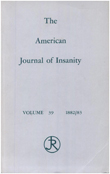DSM-IV and the disappearance of agoraphobia without a history of panic disorder: new data on a controversial diagnosis
Abstract
OBJECTIVE: This analysis describes subjects who met rigorous criteria for DSM-III-R agoraphobia without a history of panic disorder and makes inferences from these data regarding relationships among agoraphobia without a history of panic disorder, panic disorder, and panic disorder with agoraphobia. METHOD: Twenty-six subjects (seven men and 19 women) with agoraphobia without a history of panic disorder were identified from among 711 subjects recruited for a multicenter, longitudinal anxiety disorder study. Narrative transcripts prepared by raters from study evaluations were coded for limited symptom attacks, situational panic, catastrophic cognitions, and possible precipitants and stressors, course, and somatic and psychosocial treatments received. RESULTS: Sixty-five percent of the subjects reported experiences consistent with situational panic attacks, and 57% had definite or probable limited symptom attacks; these attacks usually preceded or appeared at the same time as avoidance behavior. Eighty-one percent had catastrophic cognitions associated with agoraphobia. Twenty-six percent reported a likely precipitating factor for symptom onset, and 30% reported a definite or probable major life stressor within 6 months before symptom onset. Cognitive-behavioral treatments were relatively infrequently used. Course was relatively unchanged across the follow-up period. CONCLUSIONS: These data support a view of agoraphobia without a history of panic disorder on a continuum with uncomplicated panic disorder and with panic disorder and agoraphobia, rather than as a separate diagnosis.
Access content
To read the fulltext, please use one of the options below to sign in or purchase access.- Personal login
- Institutional Login
- Sign in via OpenAthens
- Register for access
-
Please login/register if you wish to pair your device and check access availability.
Not a subscriber?
PsychiatryOnline subscription options offer access to the DSM-5 library, books, journals, CME, and patient resources. This all-in-one virtual library provides psychiatrists and mental health professionals with key resources for diagnosis, treatment, research, and professional development.
Need more help? PsychiatryOnline Customer Service may be reached by emailing [email protected] or by calling 800-368-5777 (in the U.S.) or 703-907-7322 (outside the U.S.).



